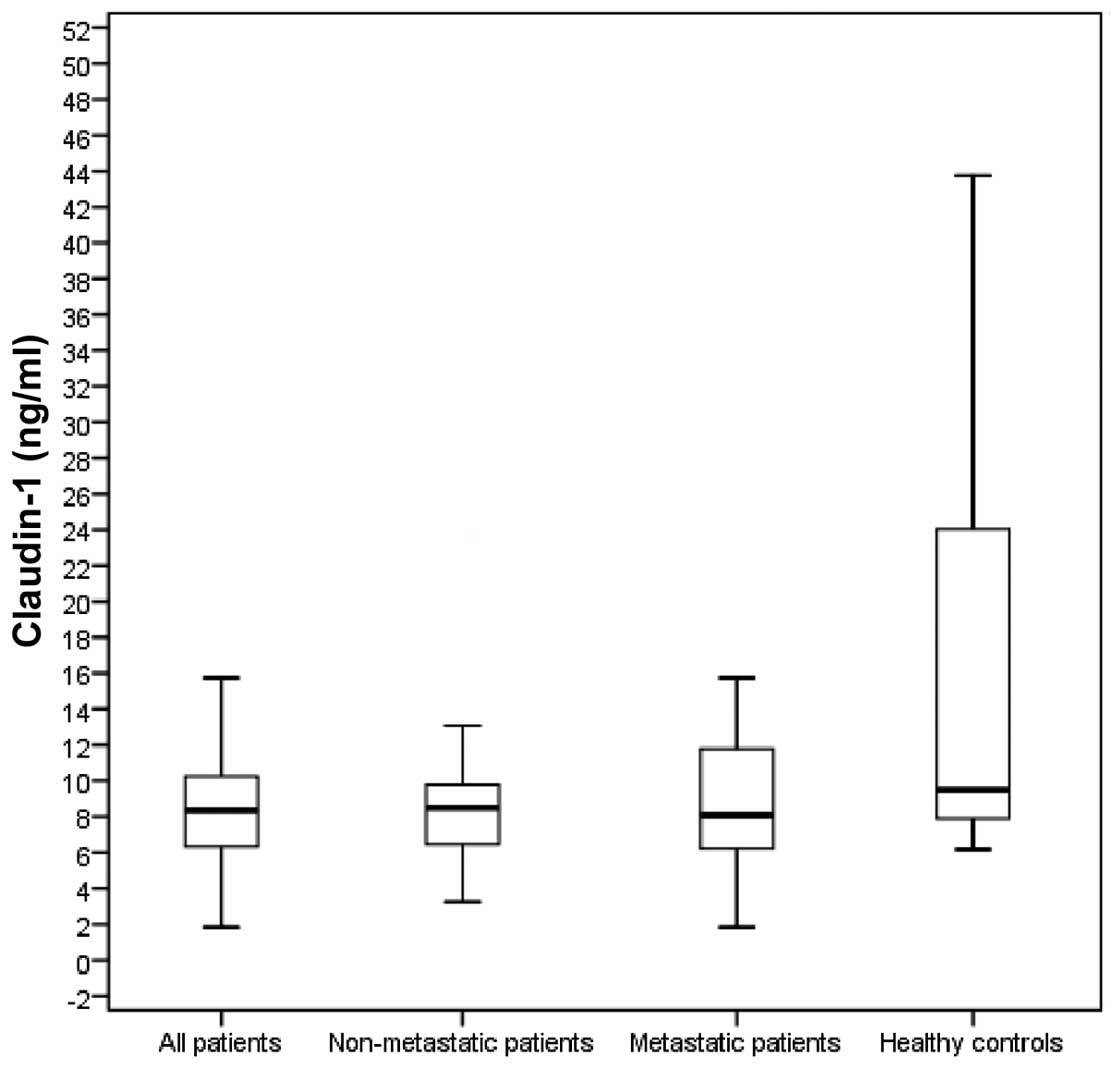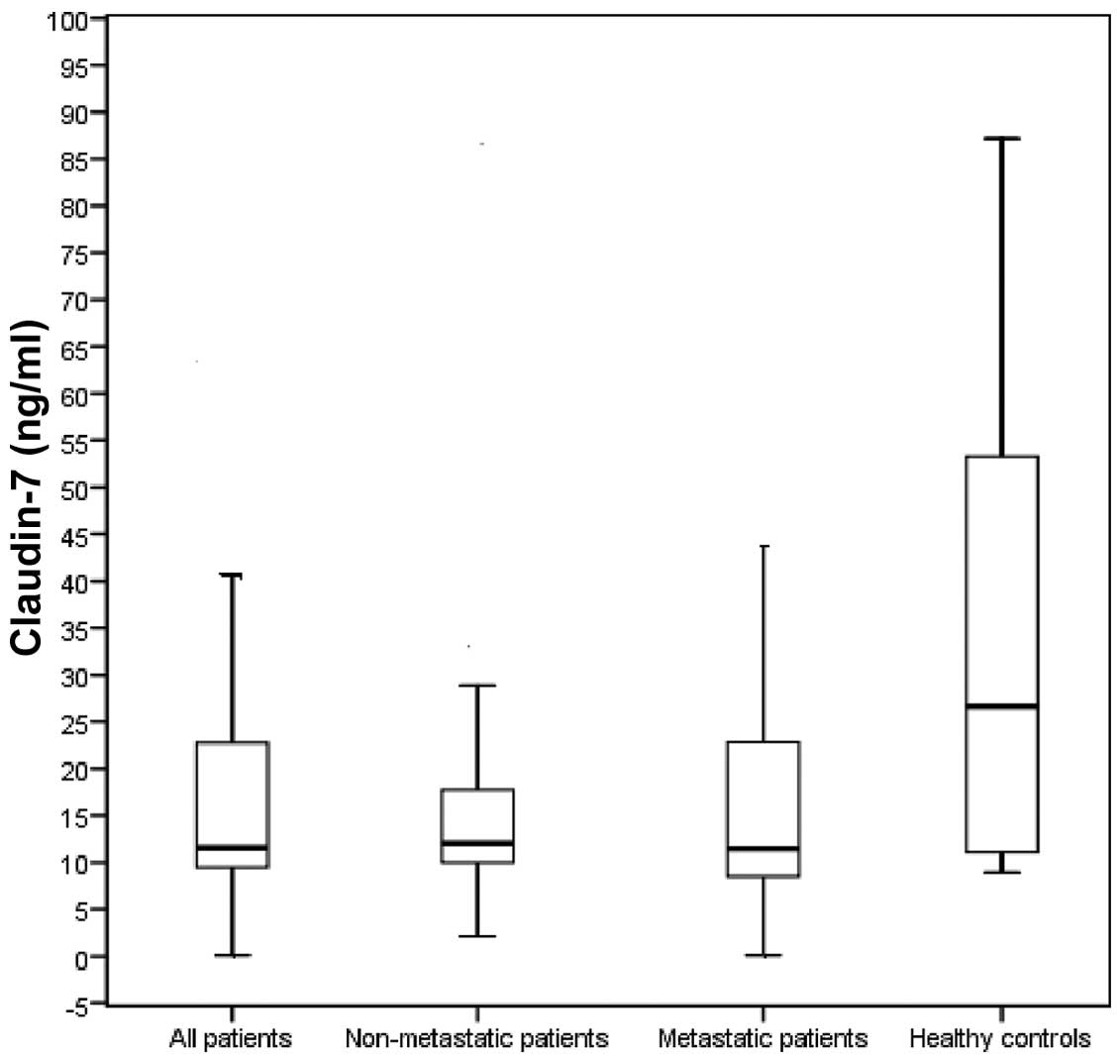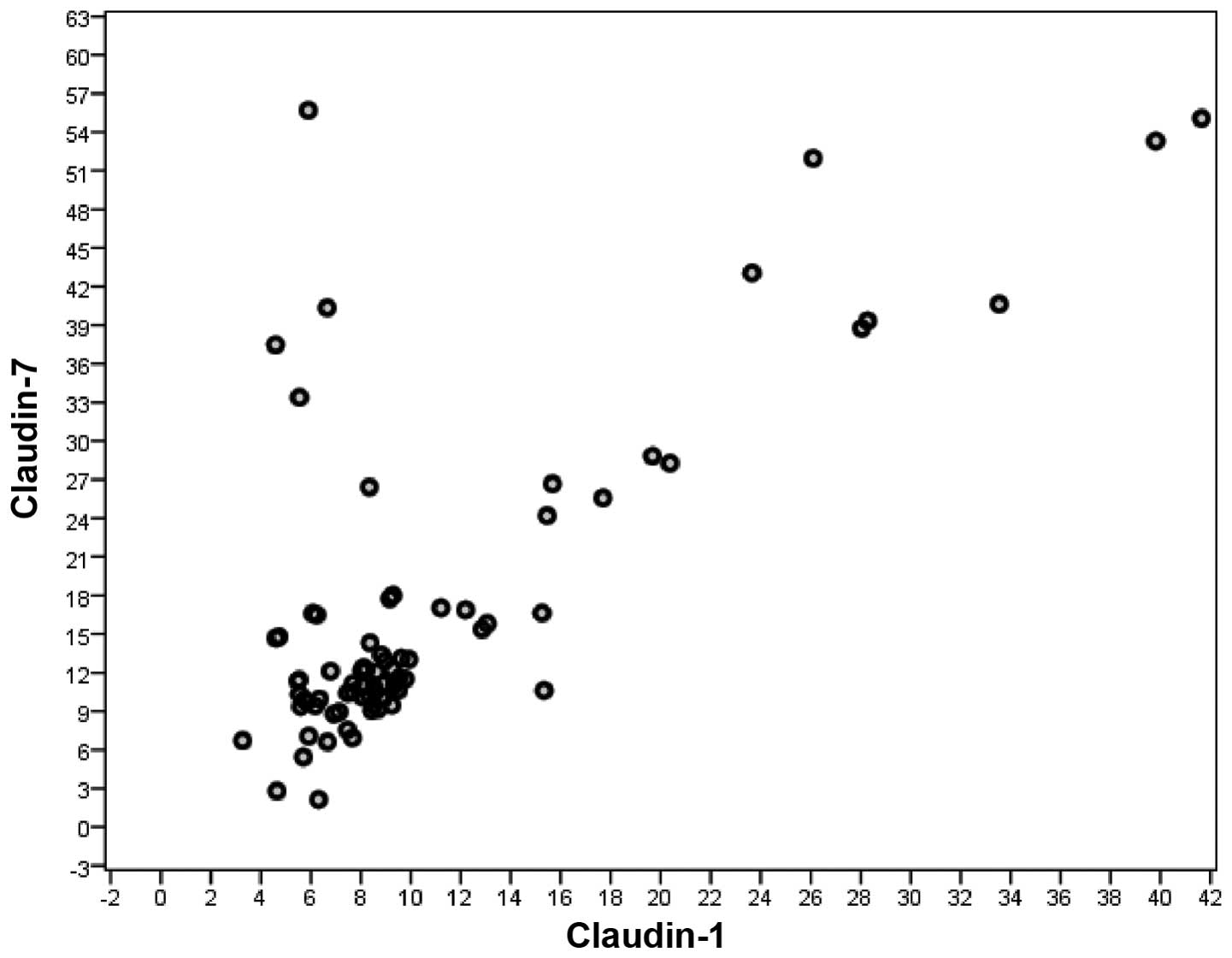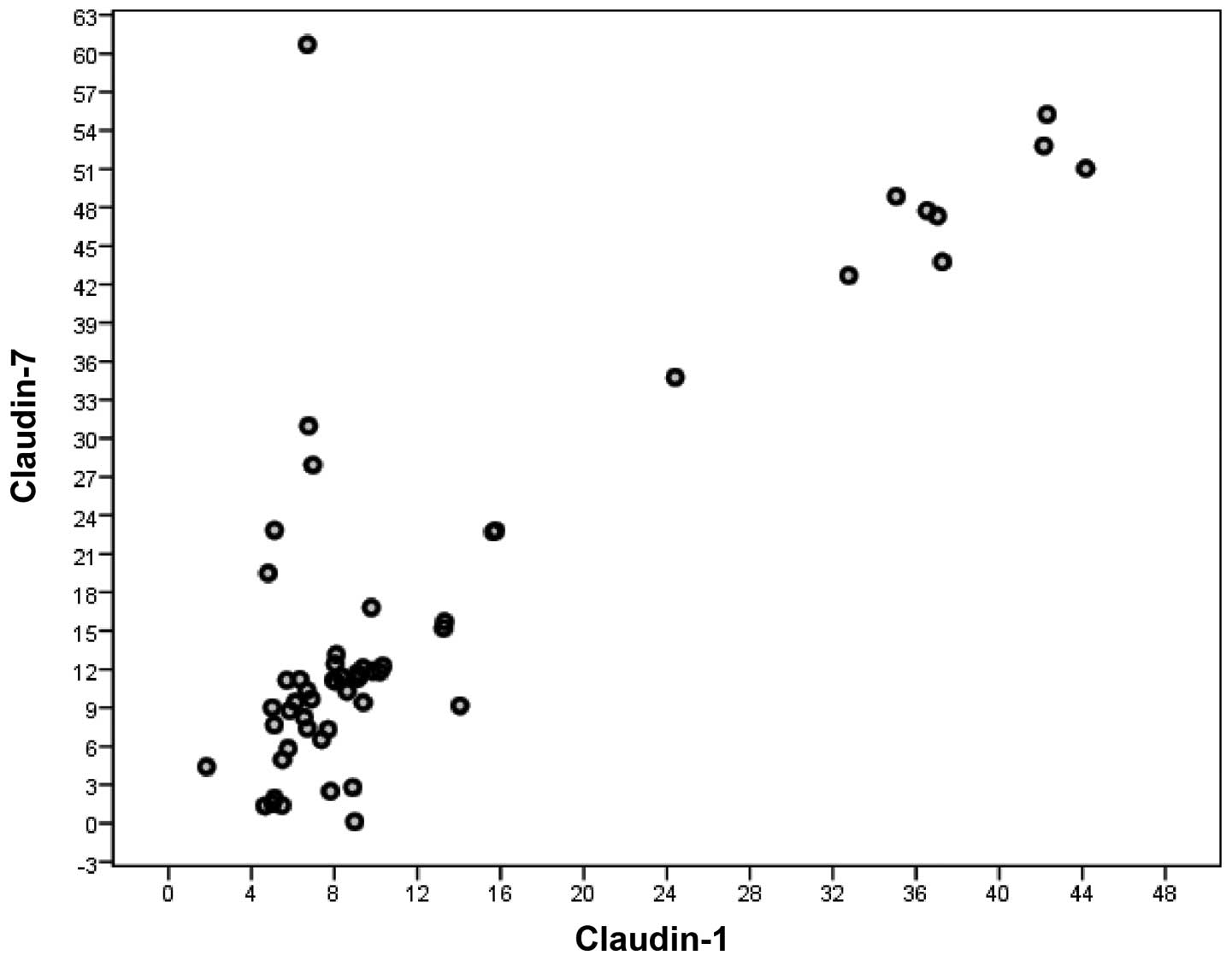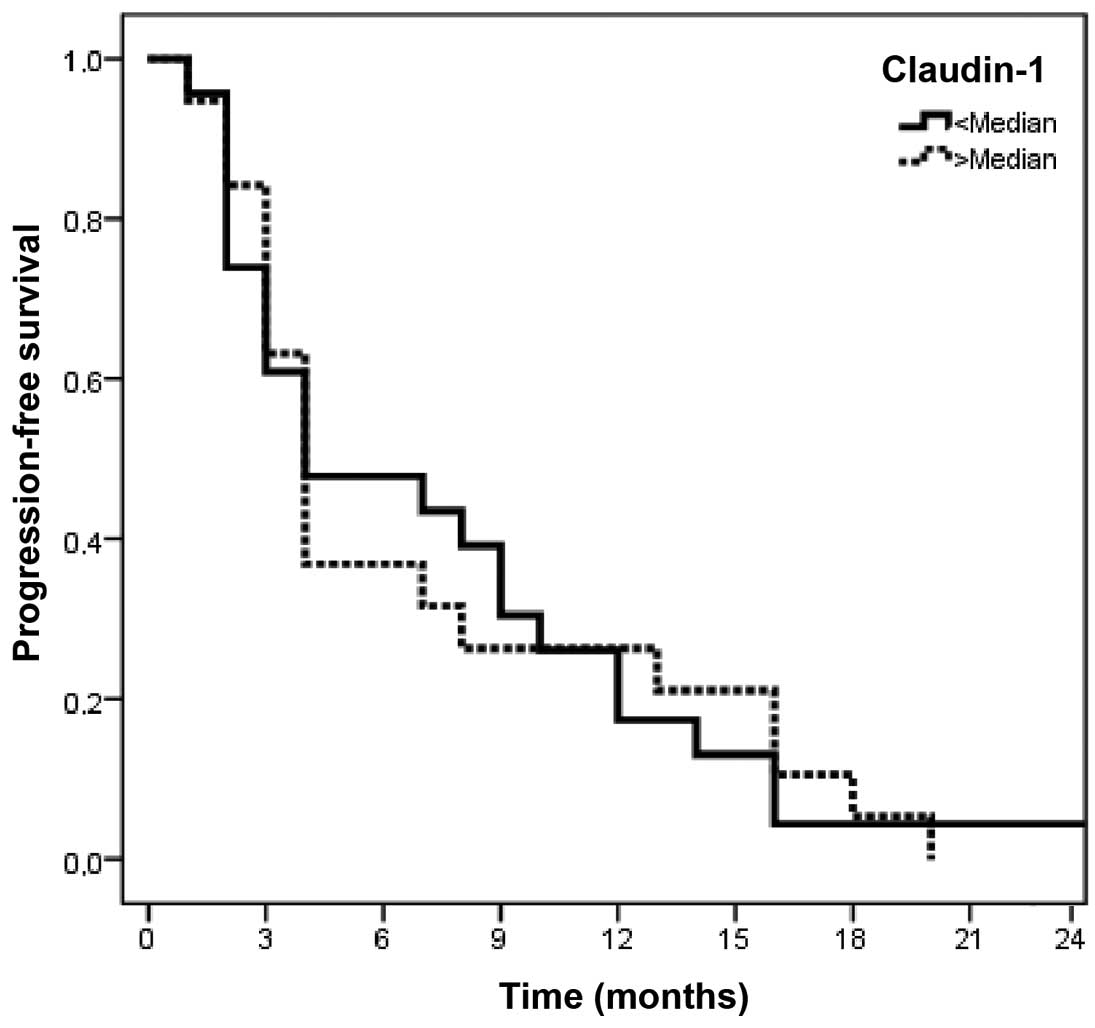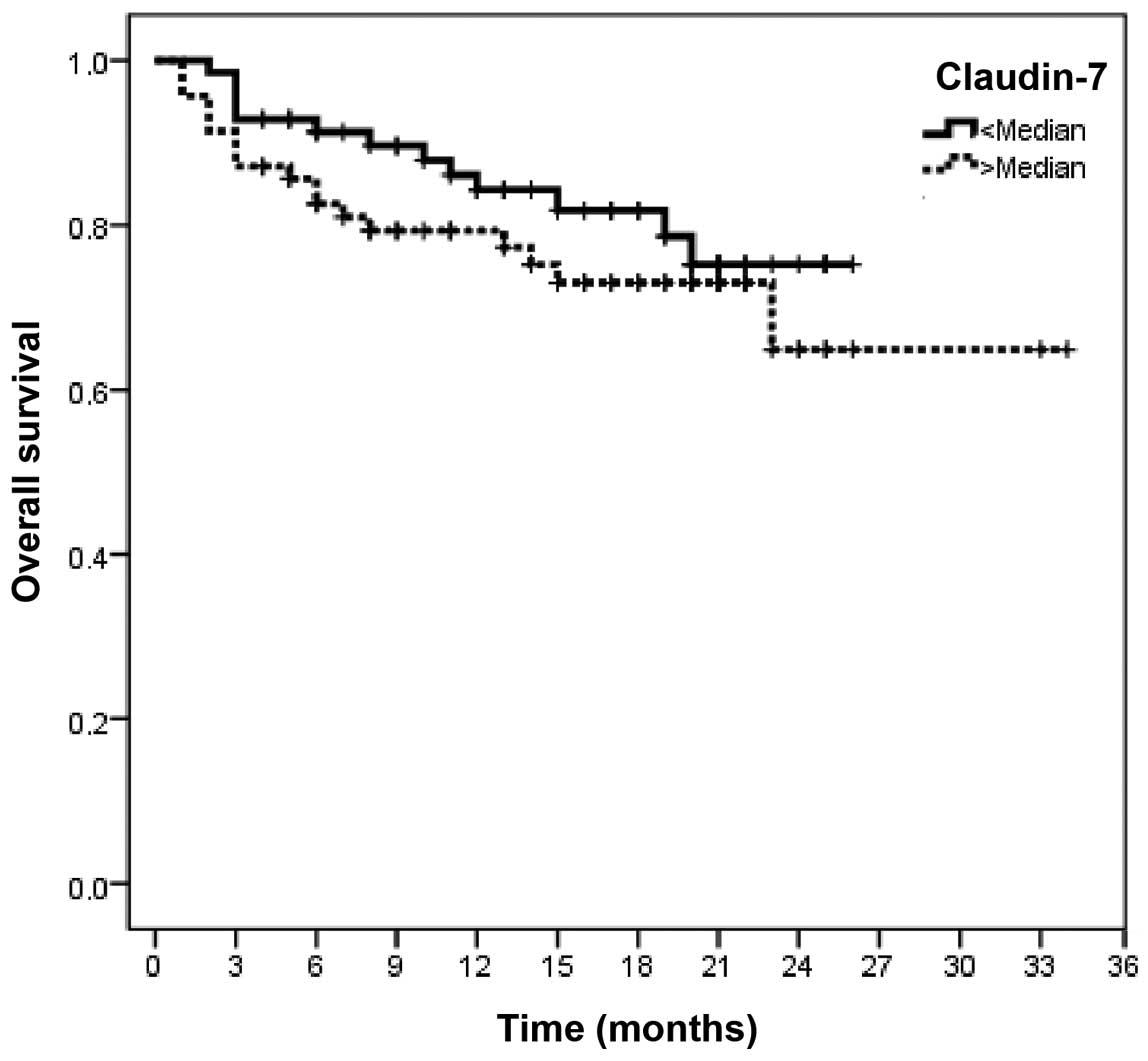Clinical significance of serum claudin-1 and claudin-7 levels in patients with colorectal cancer
- Authors:
- Published online on: August 31, 2015 https://doi.org/10.3892/mco.2015.626
- Pages: 1255-1267
-
Copyright: © Karabulut et al. This is an open access article distributed under the terms of Creative Commons Attribution License.
Abstract
Introduction
Colorectal cancer (CRC) is one of the leading causes of cancer-related mortality worldwide (1). According to the National Cancer Institute (Surveillance, Epidemiology and End Results Program), the Centers for Disease Control and Prevention (National Program of Cancer Registries), the North American Association of Central Cancer Registries and the National Center for Health Statistics, ~132,700 new cases of large bowel cancer are diagnosed annually in the USA, of which 93,090 are colon and the remainder rectal cancers. A total of ~49,700 Americans succumb to CRC annually, accounting for ~8% of all cancer deaths (2). The mortality rates from CRC have declined since the 1980s in the USA and in certain western countries. However, the mortality rates continue to increase in less developed countries with limited resources for healthcare, particularly in Central and South America and Eastern Europe (3–5). Even with the current diagnostic tools and screening programs, due to the high incidence rates of CRC, particularly in underdeveloped countries, there remains the need to develop cost-effective and convenient early diagnostic strategies, such as molecular biomarkers, to reduce the mortality rates of this disease.
Paracellular tight junctions regulate paracellular permeability and play a critical role in apical cell-to-cell adhesion and epithelial cell polarity (6). Claudins (CLDNs) are important proteins in this structure. There are currently ≥24 known members of the CLDN family (7,8). CLDNs were first named by Japanese researchers Tsukita and Furuse in 1998. The name ‘claudin’ is derived from the Latin word claudere, which means ‘to close’, suggesting the barrier role of these proteins (9).
As regards the molecular biology of cancer, it has been demonstrated that CLDNs are abnormally regulated and, therefore, are promising molecular targets for cancer diagnosis, prognosis and therapy. CLDN1 and CLDN7 are major building blocks of paracellular adhesion molecules. The significance of these tight junction proteins for local invasion by neoplastic cells and development of metastasis has been confirmed by numerous studies over the last decade and their decreased expression in CRC appears to significantly affect cell proliferation, motility, invasion and antitumor immune response (10).
In this study, we aimed to investigate the association between clinicopathological findings and the serum levels of CLDN1 and CLDN7 in CRC. To the best of our knowledge, this is the first study using ELISA, which is a more practical and cost-effective technique compared with immunohistochemistry (IHC) or polymerase chain reaction (PCR) analysis for measuring these CLDNs in CRC.
Materials and methods
Study design and eligibility criteria
Serum samples were obtained from 140 consecutive patients with CRC who were referred to the Institute of Oncology of the Istanbul University and the Istanbul Bakirköy Dr Sadi Konuk Training and Research Hospital (Istanbul, Turkey) between 2011 and 2014. All the patients were staged using the seventh edition of the American Joint Committee on Cancer tumor-node-metastasis system by radiological and pathological criteria (11).
All the patients were treated using a multidisciplinary approach. Patients with colon cancer who had undergone surgery including segmental colon resection were treated with adjuvant chemotherapy (CTx) according to their stage. Patients with rectal cancer who received neoadjuvant radiochemotherapy (RCTx) or radiotherapy (RT) had undergone low anterior resection or abdominoperineal resection. Certain patients had undergone palliative surgery and stage IV patients received palliative CTx, with or without targeted therapy (bevacizumab or cetuximab). The pretreatment evaluation included detailed clinical history and physical examination with a series of biochemistry tests and complete blood cell counts. Selection for treatment required an Eastern Cooperative Oncology Group performance status (PS) score of 0–2, and adequate bone marrow (absolute neutrophil count >1,500/µl and platelet count >100,000/µl), cardiac, renal and hepatic functions. The patients were treated with various CTx regimens, including single-agent or combination therapy. Regimens of single-agent or combination CTx were selected according to the PS of the patients and extent of the disease. The patients received one of the following treatment regimens: Simplified LV5FU2 (leucovorin 400 mg/m2, followed by 5-fluorouracil as a 400 mg/m2 bolus and a 2,400 mg/m2 infusion over 46 h every 2 weeks), capecitabine (1,000 mg/m2/b.i.d., p.o. for 14 days of each 21-day cycle), modified FOLFOX regimen (simplified LV5FU2 regimen plus oxaliplatin 85 mg/m2 every 2 weeks), FOLFIRI (simplified LV5FU2 regimen plus irinotecan 180 mg/m2 every 2 weeks), XELOX (capecitabine 1,000 mg/m2/b.i.d., p.o. for 14 days plus oxaliplatin 130 mg/m2 every 3 weeks), and XELIRI (capecitabine 1,000 mg/m2/b.i.d., p.o. for 14 days plus irinotecan 240 mg/m2 every 3 weeks). Bevacizumab was administered at a dose schedule of either 5 mg/kg every 2 weeks, or 7.5 mg/kg every 3 weeks. Cetuximab 500 mg/m2 was administered intravenously every 2 weeks.
All the patients had undergone pretreatment imaging of primary tumors with magnetic resonance imaging (MRI) or computed tomography (CT). For patients with evaluable imaging studies prior to and following treatment, radiological response was recorded according to the Response Evaluation Criteria in Solid Tumors, version 1.1, and classified as complete response (CR), partial response (PR), stable disease (SD), or progressive disease (PD) (12). The tumor response after 2 months of CTx was used for statistical analysis. Follow-up for metastatic disease included clinical and laboratory tests, and CT or MRI, depending on which imaging method was used at baseline, and performed at 8-week intervals during CTx or every 12 weeks for patients receiving no anticancer treatment. Patients with either CR or PR were classified as responders, whereas patients with SD or PD were considered as non-responders.
This study was approved by the Institutional Review Board of the Institute of Oncology, Istanbul University. Baseline demographic, clinical and laboratory data including age, gender, PS, tumor marker levels, KRAS mutation status and treatment details, were retrospectively collected for all patients using uniform database templates to ensure consistent data collection. The comorbidities of the patients mainly included cardiac and metabolic diseases.
The control group consisted of 40 age- and gender-matched healthy controls were age and gender matched to the patients. with no previous history of malignancy or autoimmune disorders. Blood samples were obtained from CRC patients at first admission, 1 month after surgery and 2 weeks prior to adjuvant or palliative CTx. Blood samples from healthy controls were collected into dry tubes and serum was separated from cellular elements by centrifugation (at 1,788 × g) within 30 min after the blood samples were stored at −80°C until analysis. All the samples were collected following approval by the Institutional Review Board and provision of written informed consent by all the participants.
Measurement of serum CLDN1 and CLDN7 levels
A double-antibody sandwich ELISA was used to determine the levels of CLDN1 and CLDN7 (cat. nos. YHB0737Hu and YHB0720Hu, respectively; YH Biosearch Laboratory, Shanghai, China) in the samples. in the samples. The undiluted serum samples and standards were added to the wells, which were pre-coated with human CLDN1 and CLDN7 monoclonal antibody against human CLDN1 and CLDN7. Then, the anti-CLDN1 and anti-CLDN7 antibodies labeled with biotin and the streptavidin-horseradish peroxidase conjugate were added to the wells to form an immune complex. After incubation at 37°C for 1 h, the unbound material was washed away with the diluted washing concentrate provided by the kit. Chromogen TMB (3,3′, 5,5;-tetramethylbenzidine) solution was added as the substrate for HRP and incubated at 37°C for 10 min (protected from light) for the conversion of the colorless solution to a blue solution, the intensity of which was proportional to the amount of CLDN1 and CLDN7 in the sample. Under the effect of the acidic stop solution, the color turned to yellow and the colored reaction product was measured using an automated ELISA microplate reader (ChroMate® 4300; Awareness Technology, Inc., Palm City, FL, USA) at 450 nm. The results were expressed as ng/ml.
Statistical analysis
IBM SPSS software for Windows, version 21.0 (IBM Corp., Armonk, NY, USA) was used for data analysis. Continuous variables were categorized using median values as the cut-off point. The Chi-square test or one-way analysis of variance were used for group comparison of categorical variables, and the Mann-Whitney U test or Kruskall-Wallis test were used for comparison of continuous variables. The Spearman's rank order correlation was used for correlation analysis. Overall survival (OS) was calculated from the date of first admission to disease-related death or date of last contact with the patient or any family member. Progression-free survival (PFS) was calculated from the date of admission to the date of first radiographic evidence of disease progression, with/without elevated serum tumor marker levels. The Kaplan-Meier method was used for the estimation of survival distribution and differences in PFS and OS were assessed by the log-rank statistics. All the statistical tests were two-sided and P<0.05 was considered to indicate a statistically significant difference.
Results
Patient characteristics
A total of 140 patients who were pathologically diagnosed with CRC between May, 2011 and August, 2014, were included in the present study. The baseline demographic and histopathological/laboratory characteristics of the patients are summarized in Table I. The median age of the patients was 60 years (range, 24–84 years), with a male predominance (n=96, 69%). A total of 43 patients had family history of cancer, including 12 lung cancers and 14 CRCs. The tumor localization was in the rectum in 59 (42%) and in the colon in 81 (58%) patients (right colon, n=17; hepatic flexure, n=5; transverse colon, n=5; descending colon, n=13; splenic flexure, n=1; sigmoid colon, n=37; multiple synchronous colon tumors, n=3; and rectosigmoid junction tumors, n=6). The most frequent metastatic sites were the liver (n=40, 67.8%) and the peritoneum (n=17, 28.8%). The rate of synchronous (n=34) and metachronous metastasis (n=25) was 57.6 and 42.4%, respectively. Of the 37 patients with rectal cancer who received neoadjuvant treatment, 28 received fluoropyrimidine-based RCTx, whereas 9 received short-course RT. A total of 71 patients who were treated with adjuvant CTx received one of the following treatment regimens: Simplified LV5FU2/capecitabine (n=14), mFOLFOX regimen (n=26), and XELOX (n=31). Palliative CTx included oxaliplatin-based or irinotecan-based combination CTx regimens and single-agent fluoropyrimidine in 24, 22, and 9 patients, respectively. Bevacizumab was administered to 36 patients, whereas 15 patients received cetuximab as the targeted agent. Response to CTx was observed in 31% of the 55 metastatic patients who received palliative CTx.
Comparison of CLDN1 and CLDN7 levels between CRC patients and controls
The levels of serum CLDN1 and CLDN7 of all CRC patients and healthy controls are presented in Table II. The baseline serum CLDN1 levels were significantly lower in all the patients compared with those in the control group (8.4 vs. 9.5 ng/ml, respectively; P=0.005). The baseline serum CLDN7 levels of all the patients were also significantly lower compared with those in the control group (11.57 vs. 26.64 ng/ml, respectively; P<0.001). The baseline serum CLDN1 levels in non-metastatic (stage II/III; 8.5 ng/ml) and metastatic patients (8.1 ng/ml) were significantly lower compared with those in the control group (P=0.008 and 0.02, respectively; Fig. 1). The baseline serum CLDN7 levels in non-metastatic (12.05 ng/ml) as well as those in metastatic patients (11.45 ng/ml) were also significantly lower compared with those in the control group (both P-values = 0.002; Fig. 2).
Correlation between serum levels of CLDN1 and CLDN7 and clinicopathological factors
The correlation between the serum levels of CLDN1 and CLDN7 and clinicopathological factors is shown in Tables III and IV. Poor PS and high carcinoembryonic antigen (CEA) levels were found to be associated with lower serum CLDN1 concentrations for all patients (both P-values = 0.03). High tumor stage and high CEA levels were found to be correlated with lower serum CLDN7 concentrations for all patients (P=0.04 and 0.02, respectively).
Table III.Results of comparisons between the serum assays and various demographic and disease characteristics. |
Table IV.Results of comparisons between the serum assays and various histopathological characteristics and laboratory parameters. |
A significant correlation was observed between serum CLDN1 and CLDN7 levels in all CRC patients (rs=0.672, n=140, P<0.001). Such a correlation was not observed between serum CLDN1 and CLDN7 levels in non-metastatic CRC patients (rs=0.632, n=81, P<0.001), but it was observed between serum CLDN1 and CLDN7 levels in metastatic CRC patients (rs=0.706, n=59, P<0.001) (Spearman's correlation) (Figs. 3 and 4).
Folllow-up
The median follow-up time was 14 months (range, 1–34 months). A total of 43 patients (31%) experienced disease progression, whereas 31 of the remaining patients (22%) succumbed to the disease. The median PFS and OS of the entire group were 7.3±1.0 months (95% CI: 5–9 months) and 26.9±1.1 months (95% CI: 25–29 months), respectively. The 1-year PFS rate was 26.2% (95% CI: 12.9–39.5) and the 1- and 2-year OS rates were 82.7% (95% CI: 76.2–89.2) and 70.1% (95% CI: 58.8–81.2), respectively. There was a significant association between certain clinicopathological variables, including presence of metastasis (P=0.05), no surgical resection (P=0.01), CTx-unresponsiveness (P=0.001), high serum CEA (P=0.04) and carbohydrate antigen (CA) 19-9 levels (P=0.03) and poorer PFS (Tables V and VI). Among the clinicopathological variables evaluated, rectal localization (P=0.03), presence of metastasis (P<0.001), vascular invasion (P=0.02), perineural invasion (P=0.03), poor differentiation (P=0.02), low PS (P=0.02), no surgical resection (P<0.001), CTx-unresponsiveness (P=0.002), high serum levels of lactate dehydrogenase (LDH) (P=0.02), CEA (P<0.001) and CA 19-9 (P<0.001), and low serum levels of albumin (P=0.02), were found to be correlated with poorer OS (Tables VII and VIII). However, serum CLDN1 and CLDN7 levels exerted no significantly adverse effect on PFS or OS (CLDN1, P=0.93 and 0.48, respectively; and CLND7, P=0.43 and 0.18, respectively) (Tables VI and VIII and Figs. 5–8). Moreover, the serum CLDN1 or CLDN7 levels of metastatic and non-metastatic patients exerted no significant adverse effect on PFS or OS (CLND1: P=0.75 and 0.09, and P=0.77 and 0.07, respectively; and CLND7: P=0.56 and 0.08, and P=0.07 and 0.82, respectively) (Tables VI and VIII).
Table V.Univariate analyses of progression-free survival according to patient and disease characteristics. |
Discussion
It is commonly accepted that the risk of developing CRC is affected by environmental as well as genetic factors (13). Although certain risk factors and etiological agents have been indicated in different studies over several years (14–16), there is a need to fully elucidate the molecular background of CRC, in order to develop effective biomolecular tools to decrease the mortality rate of this disease through early diagnosis. Thus far, different molecular substances and detection techniques have been investigated for this purpose, such as tight juction proteins.
Tight junction proteins regulate cellular permeability and play a crucial role in cell-to-cell adhesion and epithelial polarity. CLDNs are major integral membrane proteins of tight junctions. CLDN loss of expression or overexpression varies in different cancer types. In hepatocellular carcinoma and renal cell carcinoma, the expression of CLDN4 and CLDN5 is lost, whereas CLDN3 and CLDN4 overexpression has been detected in pancreatic ductal adenocarcinoma and cancers of the prostate, uterus, ovary and breast. Particularly CLDN1, CLDN4 and CLDN7, which are referred to as the ‘impermeability CLDNs’ are important building blocks of paracellular adhesion molecules; it was demonstrated that their decreased expression in CRC appears to exert major effects on cell proliferation, motility, invasion and antitumor immune response (17–19).
Previous studies have investigated the role of CLDNs on different cancer types using IHC or PCR (20,21). To the best of our knowledge, this is the first study to compare CLDN1 and CLDN7 serum levels between healthy individuals and CRC patients using ELISA.
It was previously suggested that loss of CLDN expression plays a role in carcinogenesis through repression of tight junctions and cell proliferation, motility and invasion (22). Resnick et al(23) demonstrated that weak CLDN1 expression was associated with high grade and poor survival, and it was an independent predictor of recurrence. Ersoz et al(24) reported that CLDN1 expression was significantly decreased in lymph node-positive cases.
For different types of cancer, a number of studies have compared CLDN7 expression between malignant and normal tissues. It was previously reported that CLDN7 expression is lower in squamous cell carcinoma of the oesophagus (25), head and neck (26), breast (27,28) and nasopharyngeal cancer (29); however, it appears to be upregulated in ovarian (30) and gastric cancer (31). Nakayama et al (32) also reported lower expression of CLDN7 in ~80% of invasive CRCs compared with non-neoplastic tissues.
Süren et al(17) recently demonstrated a significant association between loss of CLDN1 and CLDN7 expression, as determined by IHC, and invasion depth, lymph node status, disease stage, grade, perineural invasion and lymphovascular invasion in 70 CRC patients; they observed mild loss (score 1) of CLDN1 expression in 43 (61.4%) and moderate-to-marked loss (score 2 and 3) in 27 patients (38.6%). For CLDN7, there was no loss of expression (score 0) in 16 (22.9%), mild loss (score 1) in 30 (42.9%) and moderate-to-marked loss (score 3) in 24 patients (34.2%) of the same group. Similarly, in the present study, we observed a negative correlation between CRC and the serum levels of CLDN1 and CLDN7 as determined by ELISA. The baseline serum CLDN1 levels were significantly lower in all CRC patients compared with those in the control group. Similar to CLDN1, the baseline serum CLDN7 levels of all patients were significantly lower compared with those in the control group. Our results also suggest that the decrease in the levels of CLDN1 and CLDN7 reflect the stage of the disease. The baseline serum CLDN1 levels of non-metastatic (stage II/III) and metastatic patients were significantly lower compared with those in the control group. The baseline serum CLDN7 levels of non-metastatic and metastatic patients were also significantly lower compared with those in the control group.
In another study using IHC, Nakagawa et al (33) demonstrated that, among 119 CRC patients, the postoperative OS rate was significantly higher in patients exhibiting high expression of CLDN1 compared with the low-expression group for a median follow-up of 3.9 years. The disease-free survival rate following curative surgery was also higher in the high-expression compared with that in the low-expression group. Their univariate analysis revealed that grade of differentiation, morphological type, tumor size, tumor invasion, lymph node metastasis, lymphatic invasion, venous invasion, metastasis and CLDN1 expression were significantly correlated with OS. In addition, the multivariate regression analysis indicated that high expression of CLDN1 and metastasis were independent predictors of OS. They also observed that CRC patients with high expression of CLDN1 had a better prognosis in terms of disease-free survival compared with the low-expression group, which is consistent with our findings. In our analysis, we investigated the correlation between the serum levels of CLDN1 and CLDN7 and clinicopathological factors. Poor PS and high CEA levels were found to be associated with lower serum CLDN1 concentrations for all patients. High T stage and high CEA levels were also found to be correlated with lower serum CLDN7 concentrations for all patients. Such a correlation was not observed between serum CLDN1 and CLDN7 levels in non-metastatic CRC patients, but it was observed between serum CLDN1 and CLDN7 levels in metastatic CRC patients. Our median follow-up time was 14 months (range, 1–34 months). The median PFS and OS of the entire group were 7.3 and 26.9 months, respectively. We observed a significant association between other clinicopathological variables, including presence of metastasis, no surgical resection, CTx-unresponsiveness, and high serum levels of CEA and CA19-9, and poorer PFS. Among the clinicopathological variables evaluated, localization in the rectum, presence of metastasis, vascular invasion, perineural invasion, poor differentiation, low PS, no surgical resection and CTx-unresponsiveness were found to be correlated with poorer OS, as expected. However, the serum CLDN1 and CLDN7 levels exerted no significantly adverse effect on PFS or OS over this limited follow-up time.
In conclusion, CLDN1 and CLDN7 are important barrier proteins of the human cell structure and their decreased expression in CRC appears to play a central role in tumor cell motility and invasion. Therefore, reduced serum levels of CLDN1 and CLND7, as determined by ELISA, may be a useful tool in the differential diagnosis of CRC.
References
|
Siegel R, Naishadham D and Jemal A: Cancer statistics. 2013 CA Cancer J Clin. 63:11–30. 2013. View Article : Google Scholar : PubMed/NCBI | |
|
Siegel RL, Miller KD and Jemal A: Cancer statistics. 2015 CA Cancer J Clin. 65:5–29. 2015. View Article : Google Scholar : PubMed/NCBI | |
|
Center MM, Jemal A, Smith RA and Ward E: Worldwide variations in colorectal cancer. CA Cancer J Clin. 59:366–378. 2009. View Article : Google Scholar : PubMed/NCBI | |
|
Jemal A, Simard EP, Dorell C, Noone AM, Markowitz LE, Kohler B, Eheman C, Saraiya M, Bandi P, Saslow D, et al: Annual Report to the Nation on the Status of Cancer 1975–2009, featuring the burden and trends in human papillomavirus (HPV)-associated cancers and HPV vaccination coverage levels. J Natl Cancer Inst. 105:175–201. 2013. View Article : Google Scholar : PubMed/NCBI | |
|
Kohler BA, Ward E, McCarthy BJ, Schymura MJ, Ries LA, Eheman C, Jemal A, Anderson RN, Ajani UA and Edwards BK: Annual Report to the Nation on the Status of Cancer, 1975–2007, featuring tumors of the brain and other nervous system. J Natl Cancer Inst. 103:714–736. 2011.PubMed/NCBI | |
|
Singh AB, Sharma A and Dhawan P: Claudin family of proteins and cancer: An overview. J Oncol. 2010:5419572010. View Article : Google Scholar : PubMed/NCBI | |
|
Furuse M, Fujita K, Hiiragi T, Fujimoto K and Tsukita S: Claudin-1 and −2: Novel integral membrane proteins localizing at tight junctions with no sequence similarity to occludin. J Cell Biol. 141:1539–1550. 1998. View Article : Google Scholar : PubMed/NCBI | |
|
Rahner C, Mitic LL and Anderson JM: Heterogeneity in expression and subcellular localization of claudins 2, 3, 4, and 5 in the rat liver, pancreas, and gut. Gastroenterology. 120:411–422. 2001. View Article : Google Scholar : PubMed/NCBI | |
|
Tsukita S, Furuse M and Itoh M: Multifunctional strands in tight junctions. Nat Rev Mol Cell Biol. 2:285–293. 2001. View Article : Google Scholar : PubMed/NCBI | |
|
Kyuno D, Yamaguchi H, Ito T, Kono T, Kimura Y, Imamura M, Konno T, Hirata K, Sawada N and Kojima T: Targeting tight junctions during epithelial to mesenchymal transition in human pancreatic cancer. World J Gastroenterol. 20:10813–10824. 2014. View Article : Google Scholar : PubMed/NCBI | |
|
Edge SB and Compton CC: The American Joint Committee on Cancer: the 7th edition of the AJCC cancer staging manual and the future of TNM. Ann Surg Oncol. 17:1471–1474. 2010. View Article : Google Scholar : PubMed/NCBI | |
|
Eisenhauer EA, Therasse P, Bogaerts J, et al: New response evaluation criteria in solid tumours: revised RECIST guideline (version 1.1). Eur J Cancer. 45:228–247. 2009. View Article : Google Scholar : PubMed/NCBI | |
|
Chan AT and Giovannucci EL: Primary prevention of colorectal cancer. Gastroenterology. 138:2029–2043.e10. 2010. View Article : Google Scholar : PubMed/NCBI | |
|
Moon BS, Jeong WJ, Park J, Kim TI, Min S and Choi KY: Role of oncogenic K-Ras in cancer stem cell activation by aberrant Wnt/β-catenin signaling. J Natl Cancer Inst. 106:djt3732014. View Article : Google Scholar : PubMed/NCBI | |
|
Wei EK, Giovannucci E, Wu K, Rosner B, Fuchs CS, Willett WC and Colditz GA: Comparison of risk factors for colon and rectal cancer. Int J Cancer. 108:433–442. 2004. View Article : Google Scholar : PubMed/NCBI | |
|
Fearon ER and Vogelstein B: A genetic model for colorectal tumorigenesis. Cell. 61:759–767. 1990. View Article : Google Scholar : PubMed/NCBI | |
|
Süren D, Yıldırım M, Kaya V, Alikanoğlu AS, Bülbüller N, Yıldız M and Sezer C: Loss of tight junction proteins (claudin 1, 4 and 7) correlates with aggressive behavior in colorectal carcinoma. Med Sci Monit. 20:1255–1262. 2014. View Article : Google Scholar : PubMed/NCBI | |
|
Michl P, Barth C, Buchholz M, Lerch MM, Rolke M, Holzmann KH, Menke A, Fensterer H, Giehl K, Löhr M, et al: Claudin-4 expression decreases invasiveness and metastatic potential of pancreatic cancer. Cancer Res. 63:6265–6271. 2003.PubMed/NCBI | |
|
Rangel LB, Agarwal R, D'Souza T, Pizer ES, Alò PL, Lancaster WD, Gregoire L, Schwartz DR, Cho KR and Morin PJ: Tight junction proteins claudin-3 and claudin-4 are frequently overexpressed in ovarian cancer but not in ovarian cystadenomas. Clin Cancer Res. 9:2567–2575. 2003.PubMed/NCBI | |
|
Jun KH, Kim JH, Jung JH, Choi HJ and Chin HM: Expression of claudin-7 and loss of claudin-18 correlate with poor prognosis in gastric cancer. Int J Surg. 12:156–162. 2014. View Article : Google Scholar : PubMed/NCBI | |
|
Brokalaki EI, Weber F, Sotiropoulos GC, Daoudaki M, Cicinnati VR and Beckebaum S: Claudin-7 expression in hepatocellular carcinoma. Transplant Proc. 44:2737–2740. 2012. View Article : Google Scholar : PubMed/NCBI | |
|
Singh AB, Sharma A and Dhawan P: Claudin family of proteins and cancer: An overview. J Oncol. 2010:5419572010. View Article : Google Scholar : PubMed/NCBI | |
|
Resnick MB, Konkin T, Routhier J, Sabo E and Pricolo VE: Claudin-1 is a strong prognostic indicator in stage II colonic cancer: A tissue microarray study. Mod Pathol. 18:511–518. 2005. View Article : Google Scholar : PubMed/NCBI | |
|
Ersoz S, Mungan S, Cobanoglu U, Turgutalp H and Ozoran Y: Prognostic importance of claudin-1 and claudin-4 expression in colon carcinomas. Pathol Res Pract. 207:285–289. 2011. View Article : Google Scholar : PubMed/NCBI | |
|
Usami Y, Chiba H, Nakayama F, Ueda J, Matsuda Y, Sawada N, Komori T, Ito A and Yokozaki H: Reduced expression of claudin-7 correlates with invasion and metastasis in squamous cell carcinoma of the esophagus. Hum Pathol. 37:569–577. 2006. View Article : Google Scholar : PubMed/NCBI | |
|
Al Moustafa AE, Alaoui-Jamali MA, Batist G, Hernandez-Perez M, Serruya C, Alpert L, Black MJ, Sladek R and Foulkes WD: Identification of genes associated with head and neck carcinogenesis by cDNA microarray comparison between matched primary normal epithelial and squamous carcinoma cells. Oncogene. 21:2634–2640. 2002. View Article : Google Scholar : PubMed/NCBI | |
|
Kominsky SL, Argani P, Korz D, Evron E, Raman V, Garrett E, Rein A, Sauter G, Kallioniemi OP and Sukumar S: Loss of the tight junction protein claudin-7 correlates with histological grade in both ductal carcinoma in situ and invasive ductal carcinoma of the breast. Oncogene. 22:2021–2033. 2003. View Article : Google Scholar : PubMed/NCBI | |
|
Tokés AM, Kulka J, Paku S, Máthé M, Páska C, Lódi C, Kiss A and Schaff Z: The expression of five different claudins in invasive breast carcinomas: Comparison of pT1pN1 and pT1pN0 tumors. Pathol Res Pract. 201:537–544. 2005. View Article : Google Scholar : PubMed/NCBI | |
|
Hsueh C, Chang YS, Tseng NM, Liao CT, Hsueh S, Chang JH, Wu IC and Chang KP: Expression pattern and prognostic significance of claudins 1, 4 and 7 in nasopharyngeal carcinoma. Hum Pathol. 41:944–950. 2010. View Article : Google Scholar : PubMed/NCBI | |
|
Tassi RA, Bignotti E, Falchetti M, Ravanini M, Calza S, Ravaggi A, Bandiera E, Facchetti F, Pecorelli S and Santin AD: Claudin-7 expression in human epithelial ovarian cancer. Int J Gynecol Cancer. 18:1262–1271. 2008. View Article : Google Scholar : PubMed/NCBI | |
|
Rendón-Huerta E, Teresa F, Teresa GM, Xochitl GS, Georgina AF, Veronica ZZ and Montaño LF: Distribution and expression pattern of claudins 6, 7 and 9 in diffuse- and intestinal-type gastric adenocarcinomas. J Gastrointest Cancer. 41:52–59. 2010. View Article : Google Scholar : PubMed/NCBI | |
|
Nakayama F, Semba S, Usami Y, Chiba H, Sawada N and Yokozaki H: Hypermethylation-modulated downregulation of claudin-7 expression promotes the progression of colorectal carcinoma. Pathobiology. 75:177–185. 2008. View Article : Google Scholar : PubMed/NCBI | |
|
Nakagawa S, Miyoshi N, Ishii H, Mimori K, Tanaka F, Sekimoto M, Doki Y and Mori M: Expression of CLDN1 in colorectal cancer: A novel marker for prognosis. Int J Oncol. 39:791–796. 2011.PubMed/NCBI |



